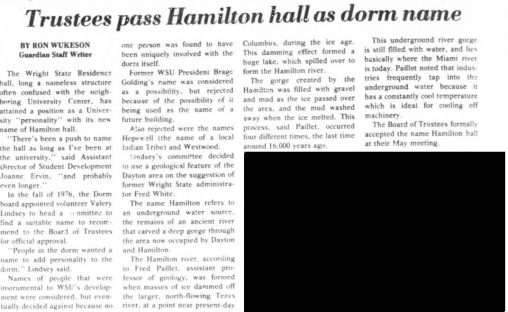
By Chris Wydman. This article was originally published on Out of the Box, a blog published by Wright State University Libraries’ Special Collections and Archives.
As we celebrate the 50th anniversary of Wright State University, Special Collections and Archives has received a lot of questions about various aspects of campus history, which has provided us the opportunity to dig in to the University Archives to try to find some answers!
One topic that has come up multiple times is the history of Hamilton Hall — Wright State’s first residence hall — and where it got its name.
Many buildings on campus are named for someone, but it has typically been for a campus founder (Stanley Allyn, Robert Oelman) or for someone who made a major gift (David Rike, Ervin J. Nutter).
But in conversations with long-time faculty and staff, no one could recall why Hamilton Hall carried that name. More curious was that while the dormitory opened in 1970, we find no mention or reference to the name “Hamilton Hall” until 1977, known only as the Wright State Residence Hall in early campus directories, maps and publications.
The answers revealed themselves in the minutes of the May 1977 Board of Trustees meeting, as described by an article in The Guardian student newspaper on July 26, 1977 (the article was written by Ron Wukeson, who today is a senior editor in the Office of Marketing).
 It turns out Hamilton was not a person at all, but rather a reference to a prehistoric river deep below the surface of the Miami Valley.
It turns out Hamilton was not a person at all, but rather a reference to a prehistoric river deep below the surface of the Miami Valley.
In the fall of 1976, a board was formed to find a suitable name for the University Residence Hall, “long a nameless structure often confused with the neighboring University Center” (which is now part of the Student Union). Students were eager to name the dorm, and while many names were considered, the committee could find no name or individual closely associated with the development of the dorm. While the names of “Golding” (in honor of Brage Golding, Wright State’s first president) and “Hopewell” (in honor of the prehistoric Native American culture) were considered, the committee ultimately selected “Hamilton Hall,” a suggestion of longtime university administrator Frederick White.
The Guardian reported that “the name Hamilton refers to an underground water source, the remains of an ancient river that carved a deep gorge through the area now occupied by Dayton and Hamilton.” Formed during the Ice Age, “this underground river gorge is still filled with water, and lies basically where the Miami River lies today.”
Wright State celebrates its 50th anniversary as an independent public university in 2017, culminating with a special Homecoming celebration Sept. 29 through Oct. 1

 Wright State marketing professor’s new book takes the horror out of managing debt
Wright State marketing professor’s new book takes the horror out of managing debt  Wright State hosts visitors from around Ohio and across the globe for NATO events
Wright State hosts visitors from around Ohio and across the globe for NATO events  Wright State expands innovative PTSD study using brain stimulation therapy
Wright State expands innovative PTSD study using brain stimulation therapy  Wright State clinches 11th Horizon League Championship, earning trip to NCAA baseball tournament
Wright State clinches 11th Horizon League Championship, earning trip to NCAA baseball tournament  Wright State media highlights, May 19–23
Wright State media highlights, May 19–23 